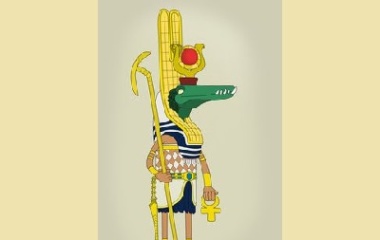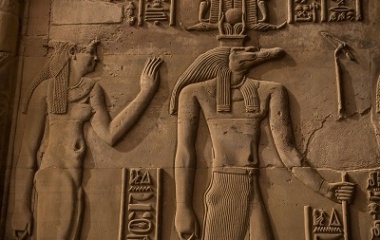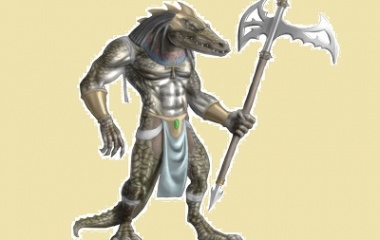- Pronunciation: So-bek
- Origin: Egypt
- Cult Center: Crocodilopolis
- Role: God of the Nile, fertility and crocodiles
- Symbols: Crocodile
- Parents: Neith and Set
- Wife: Renenutet
What is Sobek?
Sobek is the Ancient Egyptian Crocodile God of the Nile. It was believed that the Nile River was created from his sweat. Therefore, Sobek controlled the waters, and also the fertility of the soil. The Nile, by the way, was full of the aggressive and fearless creatures. It seems fitting that Sobek was revered by the Egyptians for his virility and reproductive ability.
Crocodiles are man eaters, so although Sobek was worshipped and appreciated for his gifts of vegetation from the fertile soil nourished by the impressive River Nile, he was also greatly feared. Due to his reptilian nature, Sobel operated from a place of pure instinct, was often aggressive and violent in his behaviors, and was known to be overtly sexual.
Sobek is mentioned in the Pyramid Texts, the oldest sacred texts in the world. He was the protector of the Egyptian pharaohs and their armies, and his strength and courage were their source for overcoming obstacles. He also protected them from evil, destructive magic and ill-willed sorcery.
Origin
Sobek made his first appearance in the time of the Old Kingdom, in the Lower Egyptian ancient city of Shedyet. The Greek name for Sheydet is Crocodilopolis, which means “Crocodile City.” The city is located within the region of Faiyem, and Sobek is also known as the “Lord of Faiyum.”
A special temple was built in Crocodilopolis and dedicated to Sobek. The temple grounds housed a lake, sand, and a live crocodile named Petsuchos, which means “son of Sobek”. Petsuchos was worshipped as a manifestation of Sobek, and was adorned with gold and gems. He was fed the finest quality food, including grain, meat, wine, and milk mixed with honey. When Petsuchos died, the animal was mummified and replaced with another crocodile.
The ancient Greek historian and philosopher Herodotus recorded that any person killed by a crocodile in the district of Crocodilopolis was deemed to be divine. The victims were embalmed and buried in a sacred coffin after a being given a special funeral conducted by Nile priests.
Kom Ombo was also a cult center of Sobek. It was a sanctuary for a large number of crocodiles and a worship center. The temple that Sobek shared with Horace, the war god, still stands today.
Crocodiles were often kept in pools and treated like family pets. Egyptians believed that if they fed a crocodile, they would receive blessings from Sobek. Bejeweled and mummified crocodiles of all ages and crocodile eggs have been found throughout Egypt.
Sobek was worshipped in the Old Kingdom, but his prominence really grew in the time of the Middle Kingdom. It was during this time that he was he was often fused with the falcon-headed god of royalty, Horus. Sobek rescued the four sons of Horus by gathering them into a net from the waters where they had emerged from the bloom of a lotus flower. He was adopted into the divine Triad of Horus, which also included Isis and Osiris, the parents of Horus.
Later, during the time of the New Kingdom, a god named Sobek-Ra emerged. This newer god was a fusion of Sobek and the sun god, Ra, perhaps the most important god of the Ancient Egyptians. Sobek was believed to have influence in the underworld as well. He could enliven the senses of the dead and give them sight.
Family of Sobek
The parents of Sobek were a quite a pair. His mother Neith was a terrifying war goddess. His father was Set, god of thunder, storms, war and chaos. Set is best known in Egyptian mythology for killing and dismembering his own brother, Osiris.
The wife of Sobek was Renenutet, the snake goddess and protector of the harvest. Their son is Khonsu, the god of the moon and time. The name Khonsu means “traveler”, which references the moon traveling across the sky.
Symbolic Influence
In the Old Kingdom, Sobek was most often depicted as a crocodile-headed man, and occasionally in the form of a typical crocodile. Later depictions from the Middle and New Kingdoms have attributes connecting him to Horus and Ra. Sometimes his body form is a crocodile with the head of a falcon wearing a double crown. Sobek-Ra is characterized as a crocodile adorned with a sun disk and tall plumes around his head.
In the tombs of Egypt, mummified crocodiles have been found with baby crocodiles in their mouths and on their backs. Crocodiles are one of the few non-mammals existing in nature that diligently care for their young. They often transport their offspring on their backs. The practice of preserving this aspect of the animal’s behavior via mummification seems to emphasize the protective and nurturing aspects of the fierce Sobek. He was the protector of Kings and the Egyptian people, similar to the way a crocodile protects its young.
Modern Influence
In 2012, the third novel in a series called The Kane Chronicles was published by Disney Hyperion. It’s a compilation of short stories based on Egyptian mythology and written by author Rick Riordan. In the story titled, “The Son of Sobek”, a fictional crocodile, Petsuchos, aka the “son of Sobek”, terrorizes Long Island, New York. The protagonist is transformed from an ordinary crocodile into a creature with the powers of a monster after being adorned with a magical necklace.
Tick-Tock the Crocodile, was a character featured in Disney’s Peter Pan. Tick-Tock, who had previously swallowed an alarm clock, was constantly chasing after the villainous Captain Hook to try and take a bite of him. However, after a toddler was tragically killed by an alligator at Walt Disney World in 2016, a decision was made to wipe out all references and depictions of alligators and crocodiles from any attraction at the Magic Kingdom in Florida.
A real life reptile, the Nile crocodile (Crocodylus niloticus), is the basis for the god Sobek. Real male crocodiles from the region have been known to grow to over 16 feet long, and weigh as much as 1600 lbs. The females, who guard the crocodile eggs, are smaller, but also treacherous predators. Nile crocs eat pretty much anything they can sink their sharp teeth into, including large mammals. The dangerous species is still responsible for multiple human deaths each year.
Considering the fierce, well deserved reputation of the reptiles, it stands to reason that Sobek was an influential god throughout the history of the Kingdoms. The Ancient Egyptians were in awe and fear of crocodiles, just as many people still are today.











This website is awesome! Its great for projects. I love this website!